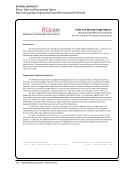SPEC Kit 329: Managing Born-Digital Special Collections and Archival Materials · 145
Rutgers University
RUcore. Born Digital Still Images
http://odin.page2pixel.org/standards/latest/RUcoreStandards-BornDigitalPhotos.pdf
IBB • RUcore Preservation Standards • Born Digital Still Images Rev: 11/18/2010
Page 6 of 7
Image Format Requirements:
• For consumer digital cameras: A direct copy of the JPG output file, without any post-
processing.
o When possible, this JPG image will be directly converted to a TIFF file, without any
changes to resolution, image quality, brightness/contrast, levels or other aspects.
o An edited copy of a digital image is permitted if the edits are the direct result of the
photographer’s intent to present the image with such modifications for artistic effect.
When permissible, an unedited “master” should also be preserved, but will not be made
publicly accessible or viewable.
• For ProSumer and professional cameras: The equipment should be able to produce images
in RAW format.
o RAW image format ensures that the images produced by the camera are unprocessed,
unedited and uncorrected.
o The camera should either be able to produce image files conforming to the Digital
Negative (DNG) file format, or interface with software that can export a DNG file from
the camera’s proprietary RAW format.
Common software packages for this purpose: Adobe Photoshop, Adobe Lightroom.
Additional listings of 3rd-party software packages can be found at
http://www.adobe.com/products/dng/supporters.html
o In addition to the DNG, a derivative TIFF file will be created and stored as a preservation
format, through which presentation JPG, PDF and Djvu or Jpeg2000 images will be
created for access by the public.
o DNG permits the photographer to specify image and lighting adjustments, while not
destructively altering the original image.
• Alternately, the equipment should be able to produced uncompressed TIF images.
o Uncompressed TIFs can be used as an archival master, but bear in mind that DNG is the
preferred format. Care should be taken when using TIFs to ensure that no image
processing occurs to the TIF file, beyond what the camera performs internally. The same
considerations will be made for artistic adjustments as in the treatment of camera-
produced JPG files.
Other Considerations:
o Image quality: the equipment must be able to produce images with a minimum of sensor noise,
and with optimal and accurate color reproduction. Such criteria is subjective, but generally most
common photography equipment from major vendors will yield acceptable images as long as
they meet the above specifications.
When possible, a non-exclusive list of tested and known-good cameras will be maintained and
made available.
o Image stabilization: If you choose a camera or lenses with Image Stabilization (IS), be certain
the IS engine is of an “optical” variety, not “electronic” or “virtual.” Optical IS uses floating
internal lens optics and gyroscopes to ensure a steady image if the camera is moving.
Electronic/Virtual IS uses software-based image editing and interpolation to artificially render a
steady image.
Rutgers University
RUcore. Born Digital Still Images
http://odin.page2pixel.org/standards/latest/RUcoreStandards-BornDigitalPhotos.pdf
IBB • RUcore Preservation Standards • Born Digital Still Images Rev: 11/18/2010
Page 6 of 7
Image Format Requirements:
• For consumer digital cameras: A direct copy of the JPG output file, without any post-
processing.
o When possible, this JPG image will be directly converted to a TIFF file, without any
changes to resolution, image quality, brightness/contrast, levels or other aspects.
o An edited copy of a digital image is permitted if the edits are the direct result of the
photographer’s intent to present the image with such modifications for artistic effect.
When permissible, an unedited “master” should also be preserved, but will not be made
publicly accessible or viewable.
• For ProSumer and professional cameras: The equipment should be able to produce images
in RAW format.
o RAW image format ensures that the images produced by the camera are unprocessed,
unedited and uncorrected.
o The camera should either be able to produce image files conforming to the Digital
Negative (DNG) file format, or interface with software that can export a DNG file from
the camera’s proprietary RAW format.
Common software packages for this purpose: Adobe Photoshop, Adobe Lightroom.
Additional listings of 3rd-party software packages can be found at
http://www.adobe.com/products/dng/supporters.html
o In addition to the DNG, a derivative TIFF file will be created and stored as a preservation
format, through which presentation JPG, PDF and Djvu or Jpeg2000 images will be
created for access by the public.
o DNG permits the photographer to specify image and lighting adjustments, while not
destructively altering the original image.
• Alternately, the equipment should be able to produced uncompressed TIF images.
o Uncompressed TIFs can be used as an archival master, but bear in mind that DNG is the
preferred format. Care should be taken when using TIFs to ensure that no image
processing occurs to the TIF file, beyond what the camera performs internally. The same
considerations will be made for artistic adjustments as in the treatment of camera-
produced JPG files.
Other Considerations:
o Image quality: the equipment must be able to produce images with a minimum of sensor noise,
and with optimal and accurate color reproduction. Such criteria is subjective, but generally most
common photography equipment from major vendors will yield acceptable images as long as
they meet the above specifications.
When possible, a non-exclusive list of tested and known-good cameras will be maintained and
made available.
o Image stabilization: If you choose a camera or lenses with Image Stabilization (IS), be certain
the IS engine is of an “optical” variety, not “electronic” or “virtual.” Optical IS uses floating
internal lens optics and gyroscopes to ensure a steady image if the camera is moving.
Electronic/Virtual IS uses software-based image editing and interpolation to artificially render a
steady image.










































































































































































































